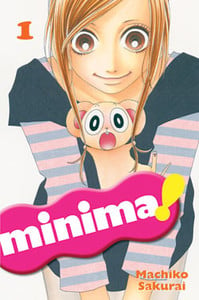Review
by Casey Brienza,Minima!
GN 1
| Synopsis: |  |
||
Ame Oikawa is a gloomy, retiring schoolgirl with an age-inappropriate fixation upon toys and character goods. With the exception of her childhood friend Midori, the rest of her class treats her with either contempt or pity. But this all changes in the blink of an eye during a class trip to an amusement park after an impulse buy at a souvenir kiosk lands Ame a stuffed toy that comes to life and talks! Toys, it seems, are actually alive—but ordinarily they only start walking and talking when humans aren't around. Nicori, on the other hand, has decided not to live a life of ignominy anymore, and the attention that he draws to himself and to his owner Ame is bound to change both their lives forever. |
|||
| Review: | |||
Wait a minute…Nicori, that minimally designed, flesh-toned creature which looks like nothing so much as a wide-eyed rat, is supposed to be a meerkat? A meerkat?! As in the South African species of diurnal mongoose??? Mangaka Machiko Sakurai must have been watching Meerkat Manor; it's the only plausible explanation. (The applicable dates work as well, in case you were wondering.) She also admits to having been watching Pixar's Toy Story, and this much beloved animated film is, without question, the single most important thematic influence upon the Minima! manga. But never mind the fascinating socio-economic implications vis-à-vis global flows and counter-flows of popular culture—wherein a Japanese manga borrows from an American film, and then that manga is repackaged by a German media conglomerate for American consumption—this influence serves the manga magnificently…by providing it a rich foundation on which to construct a secret social life of toys. For, as any veteran consumer of the medium knows, the plots of most mainstream shoujo manga are driven by the social lives of their characters, such their friendships, their romances, their interpersonal conflicts, their reconciliations, etc. Generally speaking, the scope remains limited to a single social milieu, such as that of the Japanese high school, and inasmuch as boys and girls represent different schoolyard cultures, it all starts to feel very inward-looking and myopic very quickly. Minima!, on the other hand, is a kind of cross-cultural tale dressed up as a fantasy and is, as such, a somewhat rarer bird. It would not be too much of stretch to say that Ame and Nicori are two very different kinds of people from two very different cultures who will eventually realize that, together, they are stronger than the sum of their parts. A Japanese reader may prefer to read this as “strength in solidarity,” whereas an American reader may prefer to read this as “strength in diversity.” Either way, the story is bound to achieve widespread appeal. The manga also proves surprising in the depth of its emotional affect. Out of proportion, in fact, with what is, on the face of things, a plot of, at best, only moderate originality. Ame is, unlike most shoujo heroines, neither ditzy nor spunky; if anything, she's a clinically depressed wallflower who takes refuge in collecting toys and whose classmates talk about how pathetic she is behind her back. Nicori, likewise, is an unpopular toy recently discontinued who decides to seize the reins of fate in his own two little hands, but he soon realizes that the media attention which soon comes calling just isn't the same as an owner's affection. Besides, you gotta love a palm-sized stuffed animal that marches fearlessly off to rescue its owner from kidnappers, right? Sakurai's depiction of her two characters is nuanced but not over-dramatic; I readily admit to feeling a number of sympathetic pangs while reading the first volume. I also find that, as with Toy Story, the notion that toys come to life when humans aren't looking is a provocative one that fires the imagination. No wonder Sakurai chose it! How many people started looking at their children's toys in a whole new way after Woody, Buzz…and now Nicori? (Raise your hand, now; don't be ashamed.) Oh, and for goodness' sake, don't let the dinner-plate eyes of the characters on the cover of the manga deter you. The obvious lack of effort and lackluster artistry characterizing Sakurai's color art is quite disappointing, especially given the quality of her draftsmanship on interior pages. Unlike others of her ilk, she manages line work that is attractive and delicate as well as layouts that are interesting and dynamic. Those sequences involving Nicori are especially so, and I love how seamlessly and naturally panels shift from human-sized perspectives to toy-sized ones and back again. They are a perfect complement to an entertaining little ditty of a story and just go to show that, once again, you should never ever judge a book by its cover. Minima!, much like its meerkat toy hero, comes to exuberant life when you're least expecting it. |
| Grade: | |||
|
Overall : B
Story : B
Art : B+
+ Skilled draftsmanship and a charismatic, textured plot that takes a typical shoujo storyline to the next level. |
|||
| discuss this in the forum (7 posts) | | |||
| Production Info: | ||
|
Full encyclopedia details about Release information about |
||